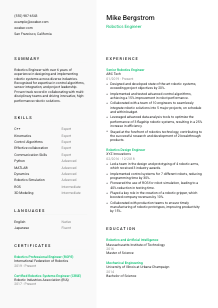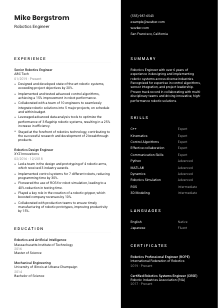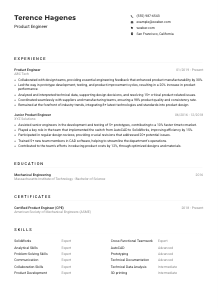Robotics Engineer Resume Example
Blending steel and circuits, but your resume feels stuck in neutral? Navigate through this Robotics Engineer resume example, polished with Wozber free resume builder. Discover how seamlessly you can program your robotic feats to align with job blueprints, taking your career trajectory from algorithms to automation!

How to write a Robotics Engineer Resume?
Greetings, aspiring Robotics Engineer! The path to securing that dream job is not just paved with your skills and experiences, but also how effectively you communicate them through your resume. With robotics engineering at the forefront of technological advancement, your resume needs to not only talk the talk but walk the walk.
Utilizing the power of Wozber, a free resume builder, this guide is your blueprint for crafting a resume that's as precise and effective as the robotic systems you aim to develop. Ready to engineer your success?
Personal Details
The 'Personal Details' section is more than just a formality; it's the opening volley in the match for the recruiter's attention. Precision and relevance are key here. Let's laser-focus on how to tailor this section for a Robotics Engineer position, ensuring it engages from the word go.
1. Your Name: The Headline
Imagine your name as the title of an intriguing book. It should stand out, acting as a beacon on your resume. Use a clear, professional font that makes your name unmissable - after all, it's the headline of your personal brand story.
2. Job Title: Your Professional Identity
Directly beneath your name, position the role you're targeting - "Robotics Engineer." This immediately tells the recruiter you're in the right place. It's like wearing a badge that says, 'I belong here.'
3. Contact Information: The Direct Line
Craft a clear pathway for potential employers to contact you. Your phone number and a professional email address are essentials. Make sure your email addresses the format of firstname.lastname@email.com, cutting any room for ambiguity.
4. Location: Setting Your Coordinates
The job calls for someone in San Francisco, California. Pinpoint your location in the contact section to align with this, subtly affirming, 'I'm right where you need me to be.' This detail reassures potential employers about your availability and reduces any concerns regarding relocation.
5. Digital Presence: Your Professional Window
Including a LinkedIn profile or a personal website can offer a deeper dive into your professional world. Ensure these platforms are polished and echo the strengths and experiences listed on your resume. This is your chance to extend the conversation beyond the confines of a traditional resume.
Takeaway
Your Personal Details section is more than just an opener; it's your opening statement. By crafting it with care, you're not just listing your details; you're initiating a professional dialogue, signaling to the recruiter that your resume is one worth reading. Position each piece of information with intent, paving the way for a memorable first impression.





Experience
The 'Experience' section is where your professional journey unfolds, showcasing your contributions to the world of robotics. Tailoring your experiences to resonate with the job at hand can set you apart as a prime candidate. Let's delve into curating a compelling narrative that highlights your prowess in robotics engineering.
- Designed and developed state‑of‑the‑art robotic systems, exceeding project objectives by 20%.
- Implemented and tested advanced control algorithms, achieving a 15% improvement in robot performance.
- Collaborated with a team of 10 engineers to seamlessly integrate robotic solutions into 5 major projects, on schedule and within budget.
- Leveraged advanced data analysis tools to optimize the performance of 3 flagship robotic systems, resulting in a 25% increase in efficiency.
- Stayed at the forefront of robotics technology, contributing to the successful research and development of 2 breakthrough products.
- Led a team in the design and prototyping of 4 robotic arms, which received 3 industry awards.
- Implemented control systems for 7 different robots, reducing programming time by 30%.
- Pioneered the use of ROS for robot simulation, leading to a 40% reduction in testing time.
- Played a key role in the creation of a robotic gripper, which boosted company revenues by 10%.
- Collaborated with production teams to ensure timely manufacturing of robotic prototypes, improving productivity by 15%.
1. Dissecting the Job Requirements
Break down the job description to understand the core competencies required. For instance, the job requires experience in "designing and developing robotic systems." Highlight experiences that showcase these skills prominently, drawing a direct line between what you've achieved and what's needed.
2. Structuring Your Battles
Organize your experiences chronologically, leading with your most recent triumphs. Each position listed should include the job title, your tenure, and the company. This structure paints a clear picture of your professional evolution and readiness for the challenges of a Robotics Engineer role.
3. Highlighting Your Victories
Illuminate your resume with specific accomplishments. If you've improved robot performance by 15%, make sure it's known. Use action verbs to bring dynamism to your contributions and quantify your achievements, providing a measurable impact of your work.
4. Quantification: The Measure of Success
Numbers capture attention. They offer a tangible scale to your achievements. Elevated a project's objective by 20%? Incorporated that! By quantifying your successes, you provide solid evidence of your effectiveness and potential as a Robotics Engineer.
5. Relevance: Keeping It on Target
Your love for homemade drones, while interesting, might not hit the mark. Focus on experiences directly tied to the skills and achievements the job description prioritizes. This laser focus demonstrates your suitability for the role and your ability to discern what's truly impactful in your professional narrative.
Takeaway
Your Experience section is the cornerstone of your resume, evidencing not just where you've been, but the trajectory of your career. It's your narrative arc in the world of robotics engineering. Align your story with the role's demands, and you transform from a candidate to a contender. Remember, each bullet point you craft is an opportunity to echo your readiness and zeal for the challenges ahead.
Education
Your Education section does more than list your academic credentials; it underscores the theoretical backbone supporting your practical achievements. In the realm of Robotics Engineering, where precision and technical prowess reign supreme, your educational background is a testament to your preparedness. Let's ensure this section reflects the rigor and relevance of your academic journey.
1. Aligning With Job Specs
Identify the educational prerequisites outlined in the job posting. The call for a "Bachelor's degree in Robotics, Mechanical Engineering, or a related field" is your cue to align your highest relevant qualification front and center, confirming your command over the foundational knowledge of robotics engineering.
2. The Blueprint of Your Academic Voyage
Present your academic credentials in a clear, straightforward manner. Starting with your highest degree, list your field of study, the conferring institution, and your graduation year. This clarity offers an uncluttered view into your educational background, making it easy for recruiters to gauge your fit.
3. Matching Degrees to Demands
Take this opportunity to align your degree titles precisely with the job's educational requirements. Having a "Master of Science in Robotics and Artificial Intelligence" significantly bolsters your candidacy, explicitly affirming your advanced expertise and specialization in critical areas of robotics engineering.
4. Coursework: Your Thematic Depth
Although not always necessary, highlighting relevant coursework can add depth to your educational profile, especially if you're near the start of your career. Showcase courses that have directly informed your competence in key areas like kinematics, dynamics, or control algorithms, linking academic theory with practical application.
5. Academic Distinctions: The Extra Mile
Graduating top of your class? Participated in groundbreaking research or robotics competitions? These achievements, while maybe less relevant at senior levels, can significantly enhance your resume at the outset, showcasing your dedication and potential to innovate in the field of robotics engineering.
Takeaway
Your Education section isn't just a list; it's a narrative of your academic dedication and intellectual rigor, essential qualities for a Robotics Engineer. By meticulously aligning your academic credentials with the job's requirements, you affirm your readiness to take on the technological challenges of tomorrow. It's not just about where you've been; it's a testament to where you're capable of going.
Certificates
In the ever-evolving landscape of robotics engineering, professional certifications serve as milestones of your continuous learning and expertise. These seals of approval offer concrete evidence of your specialized skills and dedication to staying at the cutting edge. Let's navigate through selecting and presenting the certifications that cast you in the brightest light.
1. Syncing with Job Essentials
First, understand that while the job description may not always spell out specific certifications, aligning your certifications with the core competencies required for the role demonstrates proactive learning and relevance. Even if not asked, showing you're certified in areas like ROS or advanced control algorithms can significantly bolster your credentials.
2. Curating with Precision
List certifications that directly reinforce your expertise and competency in crucial areas of robotics engineering. A certification like "Robotics Professional Engineer (ROPE)" not only showcases a recognized standard of excellence but also aligns seamlessly with the expectations of the role.
3. Dating Your Expertise
Adding dates to your certifications can be especially significant, offering a timeline of your continuous professional development. This can be particularly critical in technology and robotics, where the pace of change is rapid and knowledge quickly evolves.
4. A Pledge to Progress
In a field driven by innovation, your commitment to ongoing education through certifications signals a vibrant, forward-looking professional ethos. Regularly updating your knowledge base and skill sets through formal certifications tells potential employers that you're not just prepared for today but are also gearing up for the challenges of tomorrow.
Takeaway
In the domain of robotics engineering, your certifications are not just accolades but affirmations of your dedication to excellence and innovation. They reassure potential employers of your commitment to professional growth and your readiness to contribute at the highest levels. Present them proudly as badges of your ongoing quest for professional mastery.
Skills
The Skills section of your resume is a compact, potent showcase of your technical and soft skills arsenal. In robotics engineering, where precision and innovation are paramount, the relevance and presentation of your skills can significantly impact your job application's success. Let's engineer a skills section that highlights your readiness for the role.
1. Deciphering the Code
Start by delineating between the job description's explicit and implicit skill requirements. The specificity of skills like proficiency in "C++, Python, and familiarity with robotic simulation tools" directly mirrors the technical competencies essential for a successful Robotics Engineer.
2. Assembling Your Toolkit
Your skills list should read like a blueprint of your capabilities. Match your technical skills, such as "Kinematics" and "Control Algorithms," with soft skills like "Effective collaboration." This balance assures hiring managers of your holistic fit for the multi-disciplinary nature of robotics projects.
3. Precision Engineering
Resist the urge to list every skill you possess. Instead, focus on those pertinent to a Robotics Engineer, crafting a curated list that captures the recruiter's interest. This prioritized display of your skills demonstrates not only your proficiency but also your understanding of the role's demands.
Takeaway
Think of your Skills section as a showcase of the most powerful tools in your engineering kit. Each skill you list is a promise of your potential contribution to cutting-edge robotics projects. By aligning your skills with the job's demands, you're ready to impress upon hiring managers that you are more than a candidate; you're a solution to their engineering challenges.
Languages
In today's interconnected world, the ability to speak multiple languages can significantly enhance your appeal as a global engineering talent. While the robotics engineering field may prioritize technical skills, linguistic abilities can provide an edge, particularly in roles requiring collaboration across borders. Let's navigate the addition of languages to your resume, enhancing your profile as a versatile professional.
1. Checking the Coordinates
Scrutinize the job description for any explicit language requirements. The job seeks "proficient English speaking skills," placing English at the top of your language list as 'Native' or 'Fluent' cements your competency in the primary medium of communication.
2. Prioritizing Connectivity
Lead with languages that align with the job's requirements, ensuring your proficiency levels are accurately listed. Highlighting additional languages, for instance, Japanese as 'Fluent,' showcases your capability for broader communication and collaboration, potentially opening doors in international teams or projects.
3. Listing Your Linguistic Inventory
In addition to the required languages, include others you're proficient in, indicating your level of fluency. This diversified linguistic portfolio illustrates your potential for cross-cultural engagement and adaptability, traits highly valued in global industries.
4. Transparency in Proficiency
Clearly differentiate your proficiency levels, from 'Native' to 'Basic.' This honesty not only prevents any misunderstandings but also tailors expectations, enabling recruiters to envision where and how you can best contribute to multi-lingual teams or projects.
5. Understanding the Global Stage
For roles with an international scope or those within global companies, your multi-lingual abilities could be a significant asset, distinguishing you as a candidate versatile enough to navigate diverse professional landscapes. Emphasize this readiness to engage on a global scale.
Takeaway
In the realm of robotics engineering, where collaboration and innovation cross borders, your linguistic skills can be a noteworthy advantage. By presenting your language proficiencies, you paint a picture of a professional equipped for the challenges and opportunities of a globalized work environment. Let your resume reflect not just your technical expertise but also your capacity for worldwide connectivity.
Summary
The executive summary is your chance to distill your professional essence into a few impactful sentences. It sets the stage for your resume, encapsulating your experience, skills, and ambition in a concise narrative. For a Robotics Engineer role, it's about summarizing your journey in the field and your readiness to take on the challenges ahead.
1. Essence of the Role
Begin by internalizing the core requirements and aspirations outlined in the job description. Your summary should reflect an understanding of what it takes to excel as a Robotics Engineer – from the technical skills to the innovation mindset required.
2. Crafting Your Introduction
Open with a statement that positions you within the world of robotics engineering. Mention your years of experience, hinting at the depth and breadth of your involvement in robotics projects, and the unique perspectives or skills you bring to the table.
3. Meeting the Role's Demands
Weave in specific skills and achievements that respond directly to the job's requirements. Highlight your proficiency in key areas like "C++" and "Python," your experience in developing high-performance robotic systems, and your collaborative prowess. This customization makes it clear that you're not just any candidate; you're the right fit.
4. Keeping It Snappy
Your summary should be a powerful teaser, not a miniature autobiography. In 3-5 sentences, encapsulate your professional identity, making every word count. This brevity keeps the reader engaged and eager to delve deeper into your resume.
Takeaway
A well-crafted executive summary is like the opening gambit in a game of chess; it positions you strategically for what's to come. It sets the tone for your resume, highlighting your compatibility with the role right from the start. Reflect on your accomplishments, skills, and aspirations, weaving them into a narrative that commands attention. Let's make your introduction not just a summary, but an invitation to discover the impact you're poised to make as a Robotics Engineer.
Launching Your Robotics Engineer Journey
Congratulations on meticulous preparation for crafting your Robotics Engineer resume! With these strategic insights, Wozber's free resume builder, ATS-friendly resume template, and ATS optimization tools at your disposal, you're equipped to deploy a resume that's not only aligned with job requirements but is also poised to captivate recruiters. Your resume is now a well-engineered blueprint of your professional trajectory, designed to land you the Robotics Engineer role of your dreams.
The future awaits your expertise and innovation. Start building your resume with Wozber today, and take the first step towards transforming your career ambitions into reality.

- Bachelor's degree in Robotics, Mechanical Engineering, or a related field.
- Master's or Ph.D. is preferred.
- Minimum of 3 years of experience in robotics design, development, and implementation.
- Proficiency in programming languages such as C++, Python, and familiarity with robotic simulation tools (e.g., ROS, MATLAB).
- Strong understanding of kinematics, dynamics, and control algorithms for robotic systems.
- Effective collaboration and communication skills to work with multi-disciplinary teams.
- The role requires proficient English speaking skills.
- Must be located in San Francisco, California.
- Design and develop robotic systems, including hardware and software components, to meet specific project objectives.
- Implement and test control algorithms and sensor integration to achieve desired robot behavior and performance.
- Collaborate closely with other engineers and stakeholders to ensure seamless integration of robotics solutions into existing systems or new projects.
- Leverage data analysis tools to analyze and improve the performance of robotic systems.
- Stay updated with the latest advancements in robotics technology and contribute to research and development activities.















